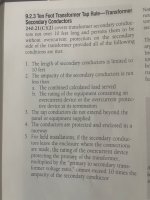Jpflex
Electrician big leagues
- Location
- Victorville
- Occupation
- Electrician commercial and residential
There’s a few things I have questions on regarding such a set up using a 30 kVA single phase 480 primary / 120/240 volt secondary step down transformer to feed a breaker sub pannel
First, on the floor mounted transformers such as in the picture shown, I have not encountered a set up where the secondary windings x1 and x2 terminals would terminate directly a 2 pole breaker before feeding the secondary wires.
Without an upstream LINE-SIDE OCPD as explained above, often smaller phase wires terminating directly to transformer secondary terminals x1 and x2 and now become TAPS. These taps are then subject to transformer secondary tap rules 240.21 such as limited to 10’ spans.
One of my thoughts is that transformers such as these DO NOT provide such a way to connect a LINE SIDE OCPD before transformer secondary wires. If you attempt to do so you will just be creating another tap secondary situation with no line side OCPD. For this reason OCPD often terminated at the secondary wire LOAD END under tap rules
This fact limits secondary windings to 10’ but NEC WORK SPACE / DEBTH DISTANCE live parts to live parts requirements between the transformer and breaker panel may require more distance between panel and transformer (entire secondary length including sections inside equipment but not just outside).
Therefore, these two pieces of equipment may not be code compliant if located so close together to not exceed a total of 10’ feet secondary conductor span (NOT JUST EQUIPMENT SPAN) between the two. It seems one code can interfere with the second code. Thaughts?
First, on the floor mounted transformers such as in the picture shown, I have not encountered a set up where the secondary windings x1 and x2 terminals would terminate directly a 2 pole breaker before feeding the secondary wires.
Without an upstream LINE-SIDE OCPD as explained above, often smaller phase wires terminating directly to transformer secondary terminals x1 and x2 and now become TAPS. These taps are then subject to transformer secondary tap rules 240.21 such as limited to 10’ spans.
One of my thoughts is that transformers such as these DO NOT provide such a way to connect a LINE SIDE OCPD before transformer secondary wires. If you attempt to do so you will just be creating another tap secondary situation with no line side OCPD. For this reason OCPD often terminated at the secondary wire LOAD END under tap rules
This fact limits secondary windings to 10’ but NEC WORK SPACE / DEBTH DISTANCE live parts to live parts requirements between the transformer and breaker panel may require more distance between panel and transformer (entire secondary length including sections inside equipment but not just outside).
Therefore, these two pieces of equipment may not be code compliant if located so close together to not exceed a total of 10’ feet secondary conductor span (NOT JUST EQUIPMENT SPAN) between the two. It seems one code can interfere with the second code. Thaughts?



